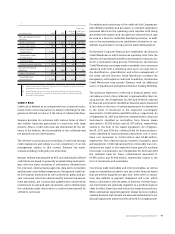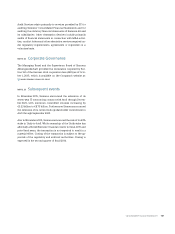Siemens 2015 Annual Report Download - page 99
Download and view the complete annual report
Please find page 99 of the 2015 Siemens annual report below. You can navigate through the pages in the report by either clicking on the pages listed below, or by using the keyword search tool below to find specific information within the annual report.
Consolidated Financial Statements
Fiscal year
2016 2017
2018 to
2020
2021 and
thereafter
(in millions of €)
Non-derivative financial
liabilities
Notes and bonds 3,243 5,667 9,175 13,746
Loans from banks 783 80 957 7
Other financial
indebtedness 1,737 3 16 50
Obligations under
finance leases 37 19 71 101
Trade payables 7,740 23 12 −
Other financial liabilities 1,189 145 98 16
Derivative financial
liabilities 943 508 537 23
Credit guarantees 859 – – –
Irrevocable loan
commitments 3,300 158 125 7
1 Based on the maximum amounts Siemens could be required to settle in the event
of default by the primary debtor.
2 A considerable portion result from asset-based lending transactions meaning
that the respective loans can only be drawn after sufficient collateral has been
provided by the borrower.
CREDIT RISK
Credit risk is defined as an unexpected loss in financial instru-
ments if the contractual partner is failing to discharge its obli-
gations in full and on time or if the value of collateral declines.
Siemens provides its customers with various forms of direct
and indirect financing particularly in connection with large
projects. Hence, credit risks arise are determined by the sol-
vency of the debtors, the recoverability of the collaterals and
the global economic development.
The effective monitoring and controlling of credit risk through
credit evaluations and ratings is a core competency of our risk
management system. In this context, Siemens has imple-
mented a binding credit policy for all entities.
Ratings, defined and analyzed by SFS, and individually defined
credit limits are based on generally accepted rating methodolo-
gies, with the input consisting of information obtained from
the customer, external rating agencies, data service providers
and Siemens’ credit default experiences. Ratings and credit lim-
its for financial institutions as well as Siemens’ public and pri-
vate customers, which are determined by internal risk assess-
ment specialists, are continuously updated and considered by
investments in cash and cash equivalents, and in determining
the conditions under which direct or indirect financing will be
offered to customers.
For analysis and monitoring of the credit risk the Company ap-
plies different systems and processes. A central IT application
processes data from the operating units together with rating
and default information and calculates an estimate which may
be used as a basis for individual bad debt provisions. In addi-
tion to this automated process, qualitative information is con-
sidered, in particular to incorporate the latest developments.
Furthermore Corporate Treasury has established the Siemens
Credit Warehouse to which numerous operating units from the
Siemens Group regularly transfer business partner data as a ba-
sis for a centralized rating process. Furthermore, the Siemens
Credit Warehouse purchases trade receivables from numerous
operating units with a remaining term up to one year. Due to
the identification, quantification and active management of
the credit risk the Siemens Credit Warehouse increases the
transparency with regard to credit risk. In addition, the Siemens
Credit Warehouse may provide Siemens with an additional
source of liquidity and strengthens Siemens’ funding flexibility.
The maximum exposure to credit risk of financial assets, with-
out taking account of any collateral, is represented by their car-
rying amount. As of September , and the collateral
for financial instruments classified as financial assets measured
at fair value in the form of netting agreements for derivatives
in the event of insolvency of the respective counterparty
amounted to € , million and € million, respectively. As
of September , and the collateral held for financial
instruments classified as receivables from finance leases
amounted to € , million and € , million, respectively,
mainly in the form of the leased equipment. As of Septem-
ber , and the collateral held for financial instru-
ments classified as financial assets measured at cost or amor-
tized cost amounted to € , million and € , million,
respectively. The collateral mainly consisted of property, plant
and equipment. Credit risks arising from irrevocable loan com-
mitments are equal to the expected future pay-offs resulting
from these commitments. As of September , and
the collateral held for these commitments amounted to
€ , million and € , million, respectively, mainly in the
form of inventories and receivables.
Concerning trade receivables and other receivables, as well as
loans or receivables included in line item Other financial assets
that are neither impaired nor past due, there were no indica-
tions that defaults in payment obligations will occur, which
lead to a decrease in the net assets of Siemens. Overdue finan-
cial instruments are generally impaired on a portfolio basis in
order to reflect losses incurred within the respective portfolios.
When substantial expected payment delays become evident,
overdue financial instruments are assessed individually for ad-
ditional impairment and are further allowed for as appropriate.
























